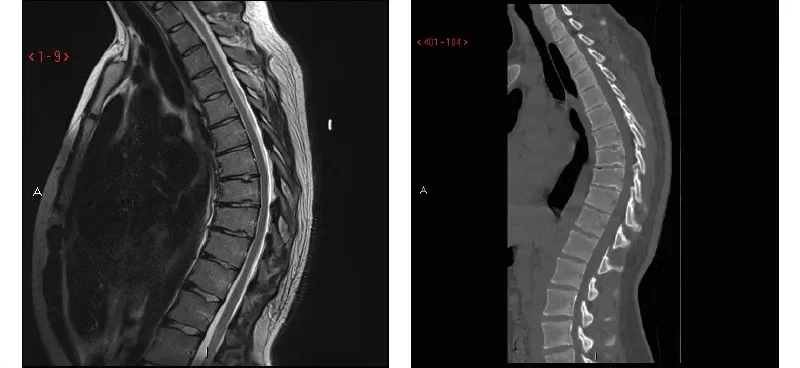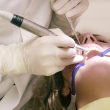When we look at a person in profile we see that the spine is not straight. Anatomically, there is a lordosis at the cervical and lumbar level, that is, the spine acquires a shape that draws a posterior concavity while at the thoracic/thoracic level the curve opens forward , which is known as dorsal kyphosis.
What in non-medical terms is known as hump, hump or hump is the accentuation of the normal physiological kyphosis of the thoracic spine. When the curvature is very pronounced, it is called hyperkyphosis .
The value of a normal thoracic kyphosis ranges between 20º-40º.
When it occurs in association with an abnormality in the coronal plane (lateral deviation of the spine) it is called kyphoscoliosis.
Causes of kyphosis
- Postural: related to bad postural habits of daily life. Age, sedentary lifestyle and obesity can cause the muscles that keep us upright to weaken.
- Congenital: from birth, due to an alteration in the formation or segmentation of the spine.
- Scheuermann’s kyphosis: It is the most common cause of kyphosis in adolescence. The vertebrae acquire a wedge shape, generating the abnormal curvature of the spine.
- Kyphosis secondary to:
- Previous surgery , tumors, infections such as tuberculosis, or nutritional deficiencies such as rickets.
- Discopathy: is the degeneration (“aging”) of the intervertebral discs that act as cushions between the vertebral bodies.
- Injuries or fractures. Compression fractures, which can occur in weakened bones (osteoporosis), are the most common. In osteoporosis, the vertebrae usually break in a wedge shape, that is, they are flattened more at the front than at the back. These compression fractures may be asymptomatic and are more common in postmenopausal women.
- Rheumatic diseases such as ankylopoietic spondylitis.
- Genetic diseases such as Ehlers-Danlos syndrome , osteogenesis imperfecta, or Marfan syndrome can cause hyperkyphosis.
Symptoms
When kyphosis is mild or incipient, it does not usually present any symptoms. Pain and stiffness appear in more advanced stages and can limit activities of daily living . It can also cause body image acceptance issues. In the most severe cases, it can cause breathing difficulties , since dorsal kyphosis modifies the size of the rib cage where the lungs are housed, digestive problems (reflux or swallowing difficulties) or neurological symptoms.
Diagnosis
Diagnosis is made with:
- Physical exploration.
- X-rays, computed tomography (CT) or magnetic resonance imaging: X-rays in posteroanterior and lateral projections can determine the degree of curvature and detect deformities in the vertebrae. The Cobb angle is usually measured from the positions of the vertebral bodies; if the angle found is greater than 40 degrees, it is a sign of increased kyphotic curvature. Sometimes a more detailed study with CT or MRI is required.
- Bone Densitometry – Used to measure bone density and may be helpful in planning surgical treatment.
- Some type of neurological test may be required in the presence of numbness or tingling sensation, frequent falls, loss of balance…
Treatment
Treatment of kyphosis depends on the cause and severity of the disease.
Conservative treatment
Treatment for kyphosis may include the following:
- Analgesics, anti-inflammatories or muscle relaxants to reduce pain.
- Medications for osteoporosis . Bone-strengthening medications can help prevent further fractures in the spine that could worsen kyphosis.
- Physiotherapy which may include :
- Stretching and strengthening exercises can improve spinal flexibility and relieve back pain.
- postural therapy
- Ultrasound, cryotherapy, thermotherapy, electroanalgesia and TENS (transcutaneous electrical nerve stimulation).
- In general , attempts are made to avoid the use of corsets or girdles , since these can improve posture but weaken the muscles,
- Immobilization. Children who have Scheuermann’s disease can slow the progression of kyphosis by temporarily wearing a spinal support during growth.
Surgery
In general, it is usually reserved for curvatures greater than 65-75º or if there is neurological involvement, although the indication for surgery may vary depending on the cause that has caused the kyphosis.
Kyphosis correction surgery is an aggressive surgery that is not exempt from complications and usually requires fixation of the spine using rods and screws.
What you should know…
-
- When kyphosis is mild or incipient, it does not usually present any symptoms. Pain and stiffness appear in more advanced stages and can limit activities of daily living.
- In the most severe cases, it can cause breathing difficulties, since dorsal kyphosis modifies the size of the rib cage where the lungs are housed, digestive problems (reflux or swallowing difficulties) or neurological symptoms.
- In general, it is usually reserved for curvatures greater than 65-75º or if there is neurological involvement, although the indication for surgery may vary depending on the cause that has caused the kyphosis.











